The American Revolution, which lasted from 1765 to 1783, saw the Thirteen British colonies in North America successfully overthrowing British rule and gaining independence. During the Revolution, the population in the colonies was itself divided into the Patriots, who supported the revolution; and the Loyalists, who wanted British rule to continue. The major causes of the Revolution included inspiration from the philosophy of the Age of Enlightenment; financial burden on the British Empire; and protest by the colonists on the issue of “no taxation without representation”. Important events leading to the American Revolutionary War include the Boston Massacre; the Boston Tea Party; and the Intolerable Acts. War began on April 19, 1775 with the Battles of Lexington and Concord. The turning point were the Battles of Saratoga, after which France entered the war on the side of America. British surrender at Yorktown on October 17, 1781 decisively tilted the war in the favor of the Americans and forced the British to begin peace negotiations. The major effects of the American Revolution include the abolition of slavery in the Northern states; native Americans losing their territory; and the initiation of the a wave of revolutions in the late 18th and early 19th centuries which became known as the Atlantic Revolutions. Know about the causes, events, battles and effects of the American Revolution through this summary.
CAUSES
The Age of Enlightenment was an intellectual and philosophical movement that dominated the world of ideas during the 18th century. Radical notions which came to the forefront during the Age of Enlightenment include the concept that all men are created equal, that the king didn’t have the divine right to rule and that a leader may only govern a society if he had the consent of those he governed. Many people who went on to become the leaders of the American Revolution were well versed with these revolutionary concepts and they fought for their rights based upon these teachings. Moreover, American revolutionary writers spurred the people to fight for their rights. The most prominent among these was Thomas Paine, who wrote Common Sense (1776), the most influential pamphlet of the Revolution.
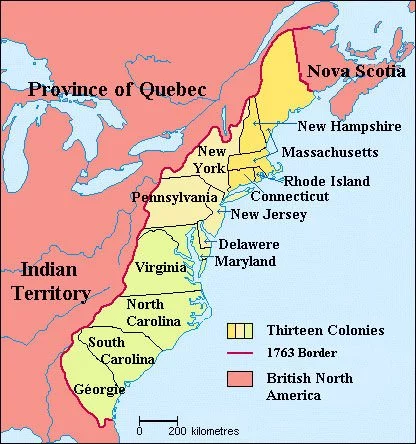
The Seven Years’ War was a conflict between a Britain led coalition and a French led coalition which was fought between 1756 and 1763. In America, the French and Indian War happened around the same time pitting the British colonies in America against New France, area colonized by France in America. Though the British won both these wars, it came at a huge cost. Britain tried to extract the cost of its standing army in America as well as lessen its financial burden by taxing its Thirteen Colonies in America. In March 1765, the British Parliament passed the Stamp Act of 1765. This was the first time that Britain had imposed direct taxes on the colonies.
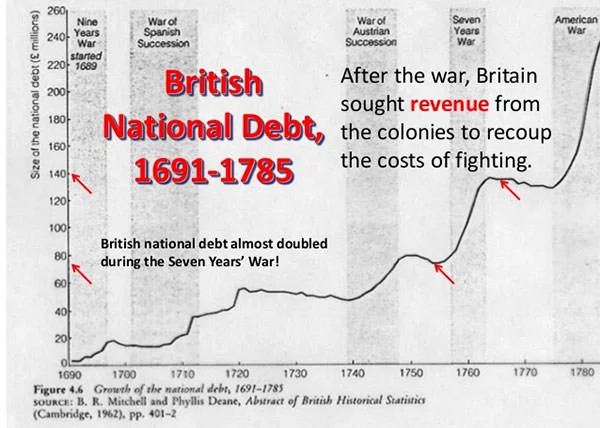
The colonists protested to the taxes, not because they were high, but due to the fact that they were being taxed by a British Parliament to which they elected no representatives. This grievance of “no taxation without representation” was one of the focal points of dissent between the colonists and the Britishers. Further, the colonists realized that if they didn’t protest against this aggressive British tax policy, there would be a substantial increase in the level of taxation in the future. This has been analyzed as the primary economic incentive of the Revolution. Despite lobbying, petitions, boycotts and violence by the colonists, the British Parliament was adamant on its right to tax the colonies and this, in turn, made conflict unavoidable.
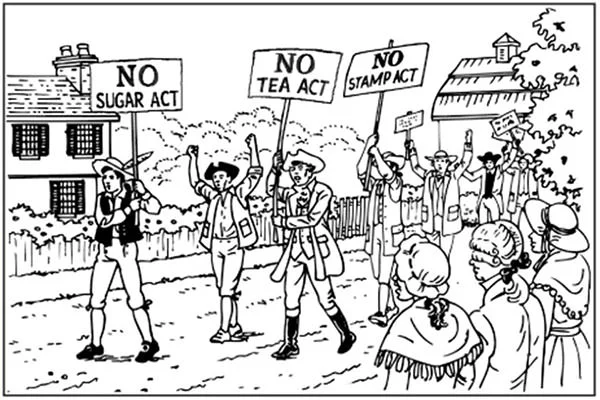
EVENTS LEADING TO THE REVOLUTIONARY WAR
On June 10, 1768, in Boston, Massachusetts, British custom officials seized HMS Liberty, a sailing boat, for alleged smuggling. This resulted in a riot due to which the custom officials were forced to flee. This, in turn, led to the 14th and 29th regiments of the British army being stationed at Boston to support crown-appointed officials. On March 5, 1770, after an altercation with an apprentice of a wig-maker, a British Private Hugh White was surrounded by Bostonians. Seven British soldiers with bayonets then moved through the crowd to rescue White. They became surrounded by a crowd of around 200 Bostonians. In the confusion, the British soldiers fired at the crowd resulting in 11 people being hit; three died on the spot while two were mortally wounded. This event became known as the Boston Massacre and it decisively turned colonial sentiment against King George III and British Parliamentary authority.

On May 10, 1773, the Tea Act was enforced by the British Parliament to aid the financially struggling British East India Company. The Act allowed the Company to sell tea in American colonies without paying taxes except the import duty under the Townshend Acts. More than 80% of the tea consumed in America at the time was smuggled Dutch tea and the Act thus adversely affected American merchants who imported tea from the Dutch. The colonists held demonstrations against the Act and mobilized opposition to delivery of the tea. Ships carrying East India Company tea were sent to Boston, New York, Philadelphia and Charleston. Apart from Boston, the protesters in the other three colonies prevented the tea from being landed. However, Thomas Hutchinson, the Royal Governor in Boston, refused to give in to the pressure. On December 16, 1773, a group of men led by Samuel Adams, some disguised as Native Americans, boarded the East India Company ships and dumped all 342 chests of tea, worth £10,000, into into the Boston Harbor. The event became known as the Boston Tea Party and it was a major incident leading to the American Revolutionary War.
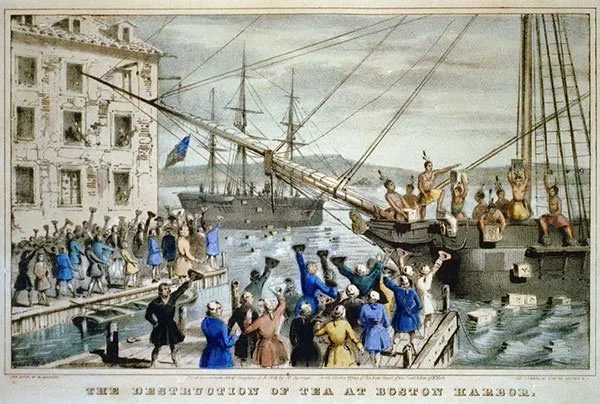
In response to the Boston Tea Party, the British government enforced four Acts to punish the Massachusetts colonists, known as the Intolerable Acts. The first was Boston Port Act, which closed the port of Boston until the colonists paid for the destroyed tea. The second was the Massachusetts Government Act, which altered the Massachusetts charter bringing it under the control of the British government and forbade town meetings without approval. The third was the Administration of Justice Act, which allowed royal officials to be tried back in Great Britain. The last and the most controversial Act was the Quartering Act which applied to all colonies. It allowed a governor to house soldiers in unoccupied houses and buildings in towns.
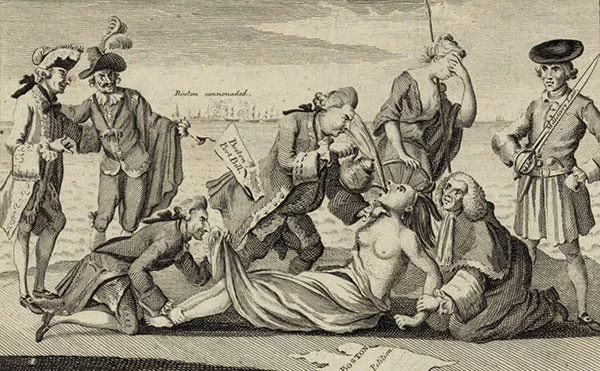
In response to the Intolerable Acts, 56 delegates from 12 of the 13 colonies met from September 5 to October 26, 1774 at Carpenters’ Hall in Philadelphia, Pennsylvania. The First Continental Congress was thus formed. After much debate, it decided that the colonies would boycott all British goods beginning on December 1, 1774. The First Continental Congress also sent a petition to King George III outlining the grievances of the colonies to the King and asking for repeal of the Intolerable Acts. However, this petition was ignored and, instead, King George III issued a Proclamation of Rebellion which stated that the colonies were “in rebellion” and the members of Congress were traitors.
American Revolutionary War
War began with the Battles of Lexington and Concord on April 19, 1775. First shots were fired at a brief skirmish at Lexington, en route to Concord. Then, a British company of around 100 men became engaged in battle with around 400 American patriots at Concord’s North Bridge. Another battle at Bunker Hill was fought two months later, on June 17. These two battles proved the British that they were wrong in believing that American citizen-soldiers could not stand up to British regulars. The British lost nearly 1,500 men in these encounters, three times the American toll. The battles were also key as their psychological benefit led to a huge boost in the morale in the colonies helping in the quick formation of the Continental Army to fight the war.
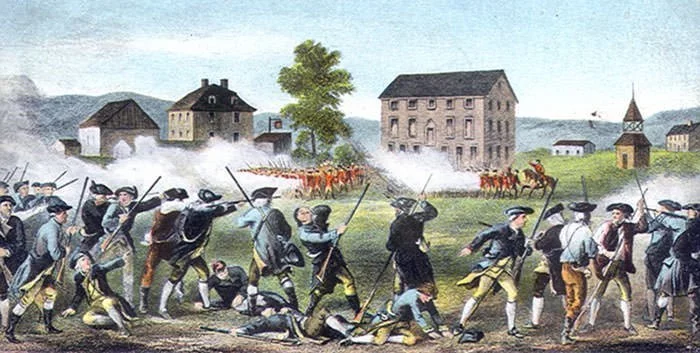
As war broke out, the Patriots overthrew the existing governments in the 13 colonies, closed courts and drove away the British officials. New constitutions were drawn up in each state to supersede royal charters; and it was declared that they were states, not colonies. On July 4, 1776, at a meeting at the Pennsylvania State House in Philadelphia, Pennsylvania, the Second Continental Congress unanimously adopted the Declaration of Independence. Drafted largely by Thomas Jefferson, it explained why the Thirteen Colonies at war with Britain regarded themselves as thirteen independent sovereign states, no longer under British rule.
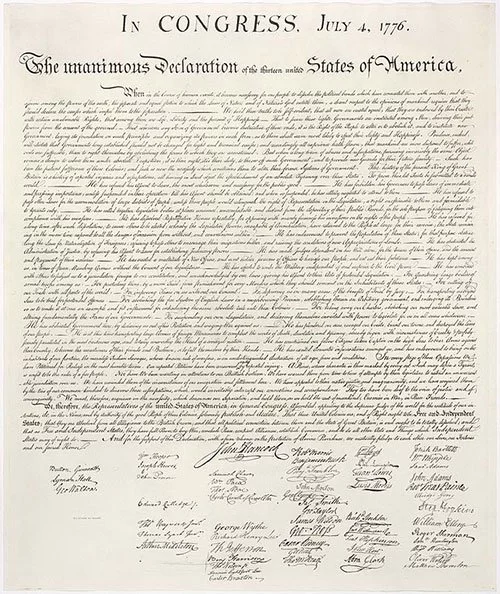
The British realized that America was too large for them to conquer. They thus aimed to impose a naval blockade and capture major American seaports. During 1776 and 1777, they captured New York, Newport and Philadelphia. George Washington, Commander-In-Chief of the Continental Army, chose the strategy of not engaging in an all out offensive to reduce the risk of losing his entire army. He instead engaged in a war of attrition to tire the British.
Frustrated as the war dragged on, the British changed their strategy. They decided to cut off New England from the rest of the colonies, contain the Continental Army and then defeat it. An army was assembled in Canada under the command of General Burgoyne. It was to advance down the Hudson Valley to Albany; while General William Howe was to march up the Hudson Valley from New Jersey. However, though Howe was able to capture Philadelphia, he could not support Burgoyne. Burgoyne was soon surrounded at Saratoga and, on October 17, he surrendered his entire army, numbering 5,800. The comprehensive victory gave France the confidence that America could win the war and this resulted in the formal Franco-American alliance in 1778. Due to this, the Battles of Saratoga are considered the turning point of the American Revolutionary War.
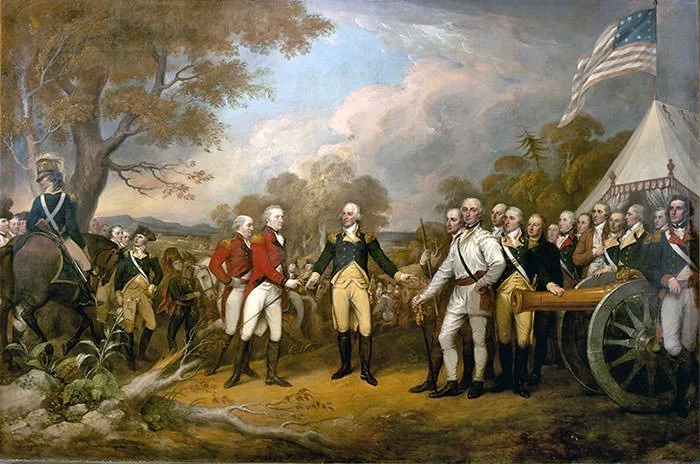
The defeat at Saratoga changed the British strategy and they now concentrated on the South. Their southern campaign began with the taking of the port of Savannah in December, 1778. The British then won major victories at Charleston and Camden during the spring and summer of 1780. However, in a combined effort during the fall of 1781, French and American forces trapped the British southern army under the command of Lord Cornwallis at Yorktown, Virginia. This resulted in the Siege of Yorktown from September 28 from October 19, 1781. After non-stop bombardment from Franco-American forces, no hope of reinforcements and inadequate supplies, Cornwallis showed the white flag on October 17 and surrendered his entire remaining force of more than 7,000. The Siege of Yorktown was the last major battle of the American Revolutionary War. It forced the British to negotiate an end to the conflict.

Effects
Around six months after the Siege of Yorktown, in April 1782, peace negotiations between the conflicting parties began in Paris. The American Revolutionary War was officially brought to an end with a set of treaties known as the Peace of Paris, which were signed in 1783 and 1784. Of these, the most important was the Treaty of Paris, which was signed on September 3, 1783 by the representatives of King George III of Great Britain and representatives of the United States of America. The article 1 of this treaty acknowledged the existence of United States’ as free, sovereign and independent states. Among other things, the Treaty of Paris set the boundaries between the British Empire in North America and the United States of America. The Peace of Paris also resulted in France gaining two small colonies, Tobago in the West Indies and Senegal in West Africa.
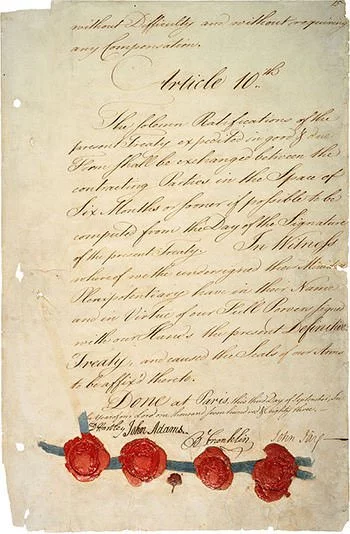
Several Native American groups participated in the American Revolution. Majority of them sided with the British hoping that a British victory would stop continued colonial expansion into their territories. However, after the war, the peace negotiations had no native representatives. The British granted the United States all land between the Appalachian Mountains and the Mississippi River even though this region was largely unsettled by whites and mostly inhabited by Native Americans. Soon after gaining independence, the United States rapidly expanded westward, often brutally, acquiring Indian lands by treaty and by force. Stockbridges and Oneidas who had supported the Americans lost lands as well as Senecas and Shawnees who had fought against them.

When the United States gained independence, an estimated 60,000 to 100,000 Loyalists left the newly found nation. Of these, some migrated to Britain. However, a great majority received land and subsidies for resettlement in British colonies in what now is Canada, especially Quebec, Prince Edward Island and Nova Scotia. Nonetheless, around 85% of the Loyalists stayed in the United States as American citizens and some who had left also returned at a later date.
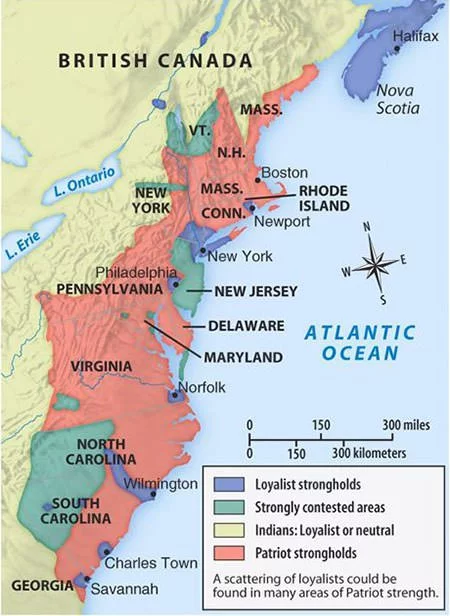
The American Revolution resulted in outright abolition or gradual emancipation in all Northern States by 1804. The Northern states passed constitutions which contained language about equal rights or specifically abolished slavery. While no Southern State abolished slavery, the revolutionary ideals did make an impact there too. Several Southern States banned the importation of slaves and allowed the individual owners the right to free their slaves by personal decision. Prior to the Revolution, there was a universal restriction in the South on masters voluntarily freeing their own slaves.
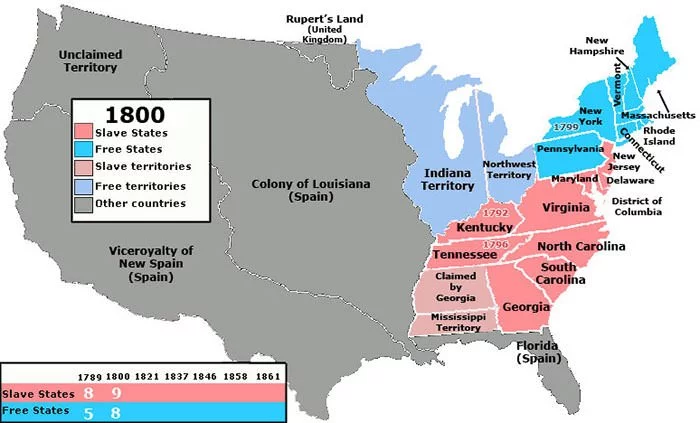
Although the American Revolution did not have a revolutionary impact on the lives of women in the United States, there were some important changes. Republicanism was the driving ideology of the revolution and this in turn led to a concept known as “Republican Motherhood”. It was believed that daughters in a family needed to be raised to uphold the ideals of republicanism so that, when they became mothers, they could pass on republican values to the next generation. Though it limited the role of a woman to the domestic sphere, Republican Motherhood encouraged the education of women. This had a long term influence as educated women would begin the women’s rights movement in the United States by mid-19th century.
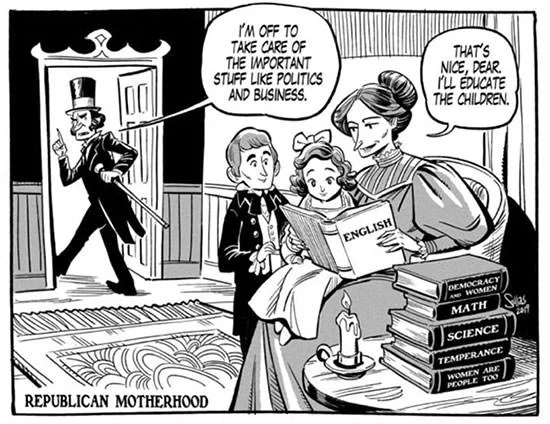
Apart from losing an important part of their Empire, Great Britain lost a huge amount of money in fighting the American Revolutionary War. This led to the national debt soaring and creating a yearly interest of nearly 10 million pounds. As a result, taxes had to be raised. At the same time, the level of unemployment fell as Britain needed more men for the army and trade with U.S. rose to the same level as trade with the colonies by 1785. The American Revolution also led to the British Empire employing two distinct forms of imperialism: one for native people and the other for European settlers. While the Britishers continued to oppress native people in Asia and Africa, they increasingly accommodated settler demands for autonomy and self-government in their white colonies.
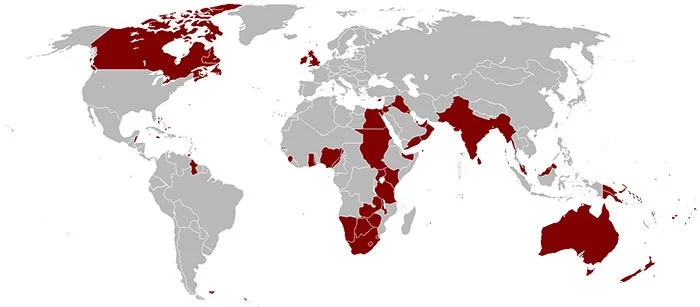
The success of the American Revolution had a major impact on the spread of liberal and revolutionary ideals internationally. It inspired anti-monarchical, democratic or independence movements in numerous nations including France, Netherlands, Polish–Lithuanian Commonwealth, Ireland and Haiti. This wave of revolutions in the late 18th and early 19th centuries became known as the Atlantic Revolutions. The American Revolution was the first of the Atlantic Revolutions and the French Revolution was perhaps the most radical.

